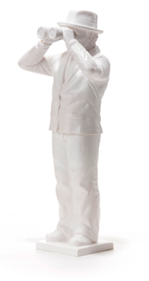
Ihr Warenkorb ist leer.


Ihr Warenkorb ist leer.

Johann Christian Friedrich Hölderlin (1770–1843) is one of the most distinguished German poets. Coming to terms with Hölderlin’s poetry, however, is what most people find rather difficult. Even Goethe and Schiller did. By contrast, philologists and philosophers, and also composers, have been fascinated and inspired by it.
What is Hölderlin’s message to us in the 21st century?
An initiative launched by Art 28, collaborating with the City of Tübingen, the Hölderlinturm (or Hölderlin Tower) Museum and the Tübingen Collegiate Church, is aimed at focusing on this question in a unique art project, and raising visual awareness for Hölderlin as an individual in the year of his anniversary. To this end, Ottmar Hörl, the renowned German conceptual artist, was invited to make Hölderlin "graspable", in the true sense of the term, and more visible.
A total of some 250 serial figures, each 66 cm, or 26 inches, in height, in monochrome gold, black, midnight blue and opal green colours, have been installed in front of the Collegiate Church and all along the Neckar Wall up to the Hölderlin Tower, in which the poet spent the second half of his life (1807-1843) after being discharged from compulsory treatment in hospital, and diagnosed "incurable".
"First and foremost, Hölderlin's 250th birthday is, of course, an occasion to celebrate the poet and to inspire people to enjoy discovering, or rediscovering, Hölderlin's oeuvre. What all this is about (…) is not a monument in the classical sense, but a move to make people think – a piece, as it were, that acts as an incentive, serves as a communication model, inviting viewers to interact and to engage in a discourse. The idea that develops from this system of serial sequence is that everyone should be in a position to take part in this artistic concept. This corresponds to the basic idea of the democratic principle of equality, which is also the basis of educational institutions such as museums. The title of the installation, ‘Pallaksch, Pallaksch’, the subversive dictum invented by Hölderlin that could be used to mean ‘yes’ as well as ‘no’, indicates that something is left open or undecided. Hölderlin experimented, added rhythm, broke the rules of syntax, forged new paths, going to the limits of what can be said, and beyond.
I deliberately refrain from prescribing any particular tendency as a way of thinking. As a three-dimensional sculpture, the work develops a direct proximity and presence. Due to its relative neutrality, the figure serves as a projection screen on which people can project their own thoughts, without ‘Hörl’ getting in the way, so to speak," Ottmar Hörl points out.
For just like Hölderlin, Hörl has a "very open and receptive approach, embracing everything that may come ...; he condenses situations until they radiate," as Manfred Schneckenburger, a former curator of documenta, once put it. Looking at Hörl’s Hölderlin not only results in self-reflection, it also helps us grow and connect with others. At the same time, the figure makes us sense just how tenuous life can be for an artist who was never one to be pigeonholed, but was prepared to go the whole hog to revolutionise poetry, and who continues to impress people today.